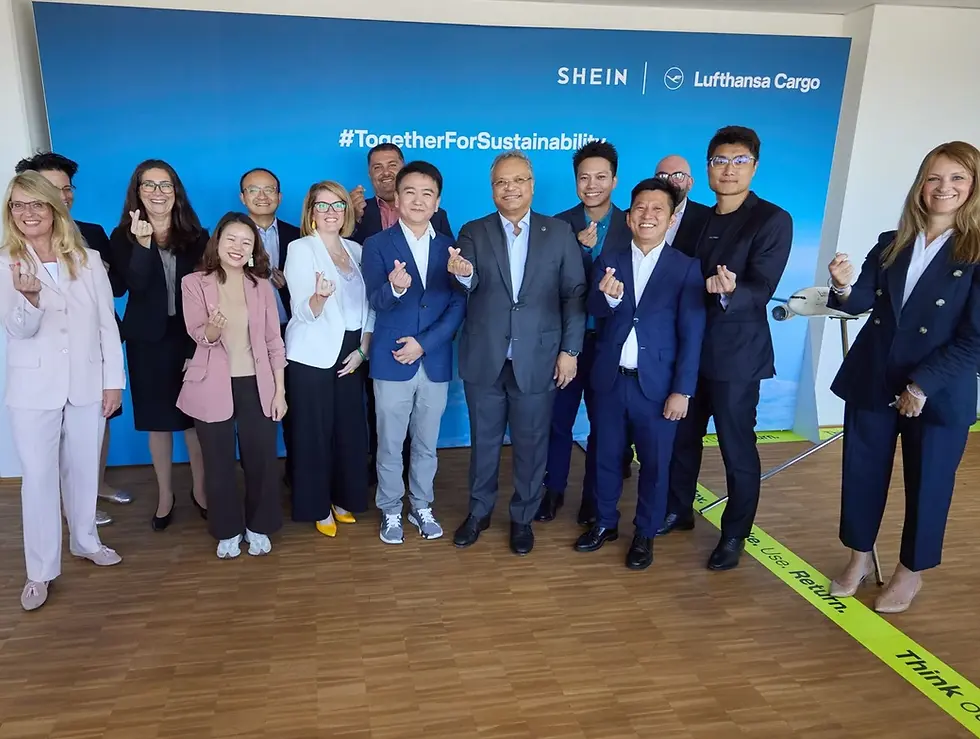From Runways to Airways: SHEIN and Lufthansa Cargo Unite on Low-Carbon Aviation
- Hanaa Siddiqi
- Aug 24
- 3 min read

SHEIN has partnered with Lufthansa Cargo to make its global deliveries more climate-friendly. The collaboration will explore the use of sustainable aviation fuel and wider strategies to cut emissions from international air freight.
At the heart of the deal is sustainable aviation fuel, also known as SAF. This liquid fuel alternative is produced from renewable feedstocks, including waste oils, agricultural residues, and non-food crops. It can be used as a substitute for conventional jet fuel, resulting in significantly lower lifecycle carbon emissions. Lufthansa Cargo, which already incorporates SAF into its operations, will supply the fuel for SHEIN shipments. Each batch will be supported by Proof of Sustainability certificates, verified by third-party standards, that document the emissions saved compared with fossil-based fuels.
According to the memorandum of understanding, the two companies anticipate rolling out SAF-based offsetting solutions within six months. Both sides stress that sustainable aviation fuel is not a silver bullet. Instead, they view it as one part of a larger carbon reduction plan that also includes new energy sources and operational improvements to make transport more efficient.
Lufthansa Cargo will share its expertise in procuring and deploying SAF, while SHEIN gains insight into how to apply these practices across its own supply chain. Since SHEIN does not operate its own aircraft but relies on third-party carriers to transport goods between suppliers and global markets, the partnership creates new opportunities to reduce emissions across its supply chain.
Ethan Shen, General Manager of Global Fulfilment at SHEIN, explains: "Lufthansa Cargo has extensive experience in driving the adoption of SAF and will provide SHEIN with opportunities to adopt lower-carbon air cargo options.
“Through this partnership, we aim to pilot and gradually expand the use of SAF where feasible, while continuing to explore additional ways to reduce the carbon footprint across our delivery network.”

A focus on transparency and data sharing
Another core element of the partnership is data collaboration. The companies will share environmental reporting and performance data to improve traceability in emissions tracking. This will involve analyzing how fuel use aligns with freight volumes and flight routing to identify areas where efficiency gains can be achieved.
By pooling their data, SHEIN and Lufthansa Cargo hope to identify patterns that could inform broader carbon reduction strategies. The memorandum also outlines plans to explore shared methods of assessing sustainability, from fleet efficiency metrics to quality assurance processes. Better traceability tools are expected to help both companies drive measurable improvements in the sustainability of air freight systems.
“Signing this memorandum with SHEIN represents Lufthansa Cargo´s commitment to implementing high-performance logistics solutions responsibly and with operational excellence,” says Ashwin Bhat, CEO at Lufthansa Cargo.

“It demonstrates the importance of concrete measures and reliable implementation in the international air freight business.”
“Together with all stakeholders within the supply chain, we are driving the development of more sustainable global supply chains in line with our purpose: Enabling Global Business."
Big-picture goals without binding targets
While the agreement outlines ambitious intentions, it falls short of setting binding targets or establishing legal commitments. Instead, it provides a framework for pilot projects and trial initiatives that can later expand into larger programs.
“While the use of SAF is one step towards reducing our transportation and distribution emissions, we recognise it as part of a broader decarbonisation strategy that should also include optimising logistics, fleet efficiency, and exploring other low-carbon solutions,” says Ethan.

Much depends on the feasibility and future availability of sustainable aviation fuel. For now, the strategy focuses on practical steps that can be tested, refined, and scaled over time. Collaboration, data exchange, and a willingness to learn together form the backbone of this partnership, which could serve as a model for how the logistics sector transitions toward lower-carbon air transport.





![LOGOTYPE [GREEN_DARK GREEN].png](https://static.wixstatic.com/media/d6e0b6_7c15be730f2c42d4ad22da5f1e69fa35~mv2.png/v1/fill/w_877,h_198,al_c,q_85,usm_0.66_1.00_0.01,enc_avif,quality_auto/LOGOTYPE%20%5BGREEN_DARK%20GREEN%5D.png)



Comments